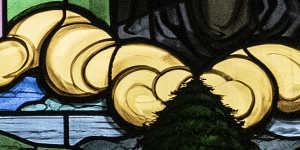
A parishioner walks within the Our Lady of Lebanon Cathedral,at Harris Park.Wolter Peeters
The site at 2a Gregory Place sits at the midpoint of what the National Trust describes as “three of the most significant historic houses in Australia”,including the nationally significant site of Elizabeth Farm,where John and Elizabeth Macarthur founded the Australian wool industry. It also directly borders the Our Lady of Lebanon Co-Cathedral,one of the busiest churches in Sydney.
The planning application,to be decided by the NSW government as a state significant development,outlines five buildings of four,six and eight storeys with half the apartments designated for affordable housing and half for long-term renters through a build-to-rent model.
The Department of Planning has received 104 submissions opposing the development,including from the Roman Catholic Church on behalf of the cathedral,the National Trust,Sydney Living Museums,Parramatta and District Historical Society,the Maronite school,and a nearby aged care home.
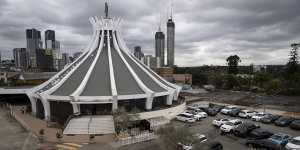
Our Lady of Lebanon Cathedral,in Harris Park.Wolter Peeters
It would be one of Sydney’s first major build-to-rent projects since state planning laws changed in 2021 to encourage this form of development. Build-to-rent means the apartments are not sold to homeowners or individual investors,but the developer instead becomes the long-term manager of the building,giving tenants a single professional landlord and,in theory,greater security of tenure.
The owner of the site is 2a Gregory Place Pty Ltd,part of a group of local companies that includes Hallmark Construction and Raadcorp. The affordable housing component – where the rent or mortgage costs are no more than 30 per cent of household income for low and moderate-income households – would be delivered by Pacific Community Housing.
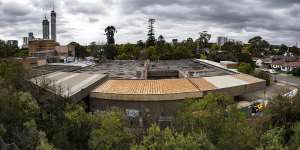
The disused pharmaceutical factory in Harris Park,proposed as the site of a major build-to-rent development.Wolter Peeters
Pacific Community Housing director Matthew Daniel,who partnered with the owner to develop the concept,said there was an apparent desire for affordable housing in Sydney,but specific proposals from the private sector were too often met with “suspicion”.
“If we are to meet the ever-growing challenge of housing stress in Sydney and the pressure on those that do not have the benefit of wealthy parents or higher individual incomes,a system that incentivises existing suppliers in housing delivery in the market to deliver new affordable housing is the best way to do it,” Daniel said.
The plans include a mix of one,two and three-bedroom apartments,resident-only rooftop terraces,and publicly accessible open space and connections to Aboriginal history such as a restored walkway along Clay Cliff Creek.
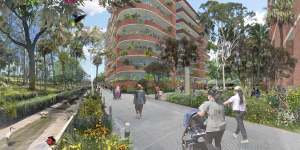
Artist’s impression of the site,which is on a disused factory in Harris Park.Supplied
Parramatta Lord Mayor Donna Davis said there were “no quick fixes” to the issues that council raised in its objection,including serious flood risks and the impacts on the neighbouring heritage sites.
“It’s clear that more affordable housing and greater housing choice are needed across our city,” Davis said. “However,careful design and planning is required to meet those needs in the right places,informed by community views.”

Hambledon Cottage,managed by the Parramatta and District Historical Society,and Experiment Farm,managed by the National Trust,are directly next door. Elizabeth Farm,managed by Sydney Living Museums,is also nearby. All three organisations lodged submissions noting their strong objections to the size and scale of the development and the missed opportunity to better link the three historic sites.
“Fundamentally,the factory on this site is a poor outcome for this place and should be removed,” the National Trust submission says. “The way to remove it,however,must not be by developing the site with close to 500 apartments.”
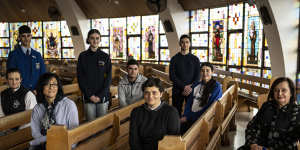
Parishioners at the Our Lady of Lebanon Co-Cathedral in Harris Park. From front left:Tina Salame,Sister Margaret Ghosn,principal of the Maronite College of the Holy Family,Cathy Saad. Students at the college are in the back row.Wolter Peeters
The cathedral’s submission notes it is generally open from 6am to 10pm but is sometimes 24-hour operation. It hosts 22 masses a week with 1000 worshippers at each service,not including frequent weddings,funerals and baptisms,while at Christmas,Easter and other feast days,up to 10,000 worshippers attend each service.
The development would be eight storeys where it borders the cathedral,though Daniel noted it would be downhill below the creek and set back from the boundary. The cathedral believes this would place the buildings on level with the base of the statue on top of the roof,providing significant over-shadowing,privacy concerns and visual impacts for the cathedral,downstairs childcare centre,and adjacent school buildings.
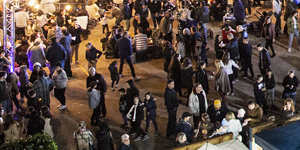
A large gathering at an event at Our Lady of Lebanon Cathedral,Harris Park.Supplied
Parishioners toldThe Sun-Heraldthat masses were often performed with the doors open to allow airflow and they fear they will be on full display for apartment residents on their balconies and roof gardens,affected by noise from the apartments,and simultaneously subject to noise complaints from their new neighbours.
Maronite College of the Holy Family school principal Sister Margaret Ghosn said the church understood the social need for affordable housing,but the proposed development was too big for the site.
“The skyline that we’re seeing with this magnificent cathedral will be overshadowed by this residential building,” Ghosn said. “That offends a lot of parishioners here because they see it as iconic;this is their church,it’s high above and looks down on everyone.”
Many of the parishioners work in property development,but they consider the proposal to be over-development given the low-rise suburban character of the area,and the impact on the historic sites and cathedral.
Long-term resident and parishioner Cathy Saad,who sits on the parish pastoral council,said:“We’re all for development,we’re all for progress,and we all have to move with the times. But you have to put it into context. It’s going to be a blow-out building if it stays that high.”
Pacific Community Housing director Matthew Daniel,who partnered with the owner to develop the concept,said the developers had consulted extensively with the community and the plans for up to eight storeys were already scaled back from an original proposal for 36 storeys.
The Morning Edition newsletter is our guide to the day’s most important and interesting stories,analysis and insights..